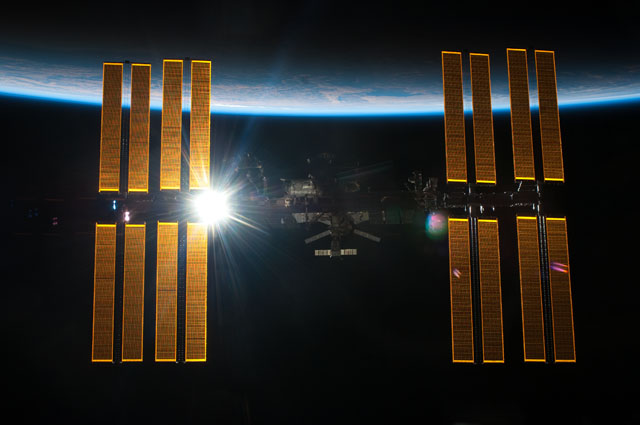ISS - International Space Station logo.
Dec. 15, 2015
International Space Station (ISS). Image Credit: NASA
The next crew members visiting the International Space Station (ISS), today launched aboard a Soyuz spacecraft, are packing multiple research investigations with them including three specifically focused on human health in space.
Determining the radiation doses inside the space station using various devices, measuring the impact of space travel on both the human immune system and an individual's microbiome, and studying the occurrence and indicators of airway inflammation in astronauts are the goals of these three investigations. This research will help highlight any health impacts to crew members’ well-being on long-duration missions, including on the journey to Mars where astronauts will need to be more self-sufficient in dealing with the extreme conditions of spaceflight.
Image above: To monitor microbial growth and ensure a safe and healthy environment on the International Space Station, crew members take regular samples of air, surfaces, and water to be analyzed. Scientists' main focus is still to prevent microbes on the station, rather than to remediate. Image Credit: NASA.
The Dose Distribution Inside the International Space Station – 3D (DOSIS-3D) investigation provides insight into combining different devices for radiation dosage monitoring, and provides lessons in how to monitor real-time radiation exposure data. This could prove beneficial to radiation monitoring for commercial and military airline crews, as well as other workers exposed to radiation.
Space station crew members are continually exposed to varying levels of radiation that can be harmful to their health, but it can be difficult to gain a complete picture of radiation within the space station. DOSIS-3D uses several active and passive detectors to determine the radiation doses inside the station. The goal is to create a three-dimensional radiation map covering all sections of the space station and a pinpoint of the distribution and levels of radiation inside the space station.
Image above: The Dose Distribution Inside the International Space Station - 3D (DOSIS-3D) Passive Detector Pack (PDP) was deployed in the Columbus European Laboratory during Expedition 39. A similar PDP will launch aboard the Soyuz spacecraft Dec. 15. Image Credit: NASA.
As part of the Microbiome investigation, scientists will assess the likelihood and consequences of alterations in the microbiome (the collection of microbes that live in and on the human body at any given time) and the related human health risk due to the extreme spaceflight environment. During a mission to space, astronauts are subject to many stressful conditions (g-forces, radiation, microgravity, anxiety, etc.) that can have a negative impact on their health. Several studies have demonstrated that space travel affects their immune systems, and have shown some evidence suggesting that changes in their microbiomes occur as well. Because the human microbiome plays a key role in human health, it is important to assess the effect of long-duration space exploration on the microbial population that inhabits the human body.
During the investigation, crew members will take periodic samples from different parts of their body and the surrounding space station environment to monitor the status of their microbiome and immune system and their interaction with the unique environment of the orbiting laboratory. Samples will also be collected from astronauts before and after their missions. These samples will help scientists determine how microgravity, the space station environment and diet affect their stress levels, immune system function and microbiome. The study will inform the design of therapies to mitigate any microbiome changes or related health issues identified during the investigation.
Image above: European Space Agency astronaut Samantha Cristoforetti on board the International Space Station working with equipment for the Airway Monitoring investigation. Image Credit: NASA.
Crew members may breathe easier thanks to another space station experiment set to launch on the Soyuz 45S. The Airway Monitoring investigation will study the occurrence and indicators of airway inflammation in astronauts resulting from dust particles in the orbiting vehicle. Scientists will use ultra-sensitive gas analyzers to measure nitric oxide exhaled by crewmembers. Monitoring these measurements will help highlight environmental conditions that exacerbate/alleviate airway inflammation in crewmembers and will help in the development of countermeasures to reduce the possibility of its occurrence. This, in turn, can help to optimize the health and performance of astronauts on long-duration exploration missions. Researchers hope to provide new insights in nitric oxide physiology, which could improve the diagnostic use of exhaled nitric oxide on Earth that could benefit patients with asthma or other airway inflammatory diseases.
From radiation to microbiome to respiratory research and more, the space station continues to conduct science off the Earth for the Earth and beyond.
Related links:
International Space Station (ISS): https://www.nasa.gov/mission_pages/station/main/index.html
International Space Station – 3D (DOSIS-3D) investigation: http://www.nasa.gov/mission_pages/station/research/experiments/184.html
Microbiome investigation: http://www.nasa.gov/mission_pages/station/research/experiments/1010.html
Airway Monitoring investigation: http://www.nasa.gov/mission_pages/station/research/experiments/1172.html
Space Station Research and Technology: http://www.nasa.gov/mission_pages/station/research/index.html
Images (mentioned), Text, Credits: NASA’s Johnson Space Center/International Space Station Program Science Office/Andrea Dunn/ Jennifer Harbaugh.
Greetings, Orbiter.ch





